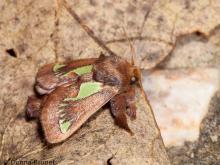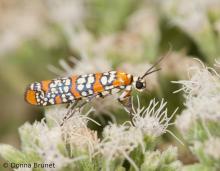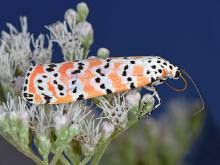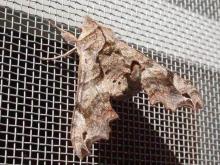Butterflies and Moths
Media

Species Types
Scientific Name
Euclea delphinii
Description
The spiny oak-slug moth is named for its caterpillar, which is armed with gaudy, stiff, stinging spines. If you touch them, the sting can feel something like a bee sting.
Media

Species Types
Scientific Name
Atteva aurea
Description
Ailanthus webworm moths visit flowers in the daytime but also come to lights at night. Larvae live communally in silken webs in tree-of-heaven, an invasive tree from Asia.
Media

Species Types
Scientific Name
About 25 species in North America north of Mexico
Description
Leaf skeletonizer moths are also called smoky moths because they have translucent smoky-brown, brownish gray, or black wings. Many species also have patches or orange or rusty color. Larvae eat all but the veins of leaves, leaving a skeleton of veins behind.
Media

Species Types
Scientific Name
Estigmene acrea
Description
The salt marsh moth, a type of tiger moth, is strikingly white with small black spots. Males have yellow-orange hindwings. The caterpillars are fast-moving woolly bears ranging from yellowish to brown to blackish.
Media

Species Types
Scientific Name
Pediasia trisecta
Description
Sod webworms are very common small moths that develop as caterpillars among the roots and leaves of grasses. They are attracted to lights at night.
Media

Species Types
Scientific Name
Utetheisa ornatrix
Description
The ornate bella moth, also called the calico moth and rattlebox moth, is one of Missouri’s most attractive moths. The colors, however, are a warning to predators that this moth is toxic if eaten. Even spiders reject them.
Media

Species Types
Scientific Name
Deidamia inscriptum
Description
The lettered sphinx is the earliest of our sphinx moths to emerge in springtime and may be seen starting in March and April. This single-brooded resident uses wild grapes, Virginia creeper, and peppervine as its caterpillar food plants.
Media

Species Types
Scientific Name
Costaconvexa centrostrigaria (formerly Orthonama centrostrigaria)
Description
The bent-line carpet and several similar geometrid moths are called carpet moths for their intricate wing patterns, reminiscent of the traditional carpets of Asia and the Middle East.
Media

Species Types
Scientific Name
Patalene olyzonaria
Description
The juniper-twig geometer is one of many geometrid moths that look like a dried-up leaf. Look for them around porch lights April through November. Larvae eat junipers, including eastern red cedar.
Media

Species Types
Scientific Name
Megalographa biloba (formerly Autographa biloba)
Description
The bilobed looper moth has a conspicuous B-shaped silvery spot on each forewing. Caterpillars of this noctuid moth eat a wide range of plants, and this species is widespread.
See Also


Media

Species Types
Scientific Name
About 1,500 species in North America north of Mexico
Description
Adult caddisflies are mothlike. Their larvae are aquatic and build portable, protective cases out of local materials, including grains of sand, bits of leaves and twigs, and other debris.
Media

Species Types
Scientific Name
Corydalus cornutus
Description
Adult eastern dobsonflies are huge and mothlike, with large wings and a weak, fluttery flight. The fiercely predaceous aquatic larvae, called hellgrammites, are well-known to anglers, who often use them as bait.
About Butterflies and Moths in Missouri
Butterflies, skippers, and moths belong to an insect order called the Lepidoptera — the "scale-winged" insects. These living jewels have tiny, overlapping scales that cover their wings like shingles. The scales, whether muted or colorful, seem dusty if they rub off on your fingers. Many butterflies and moths are associated with particular types of food plants, which their caterpillars must eat in order to survive.





















